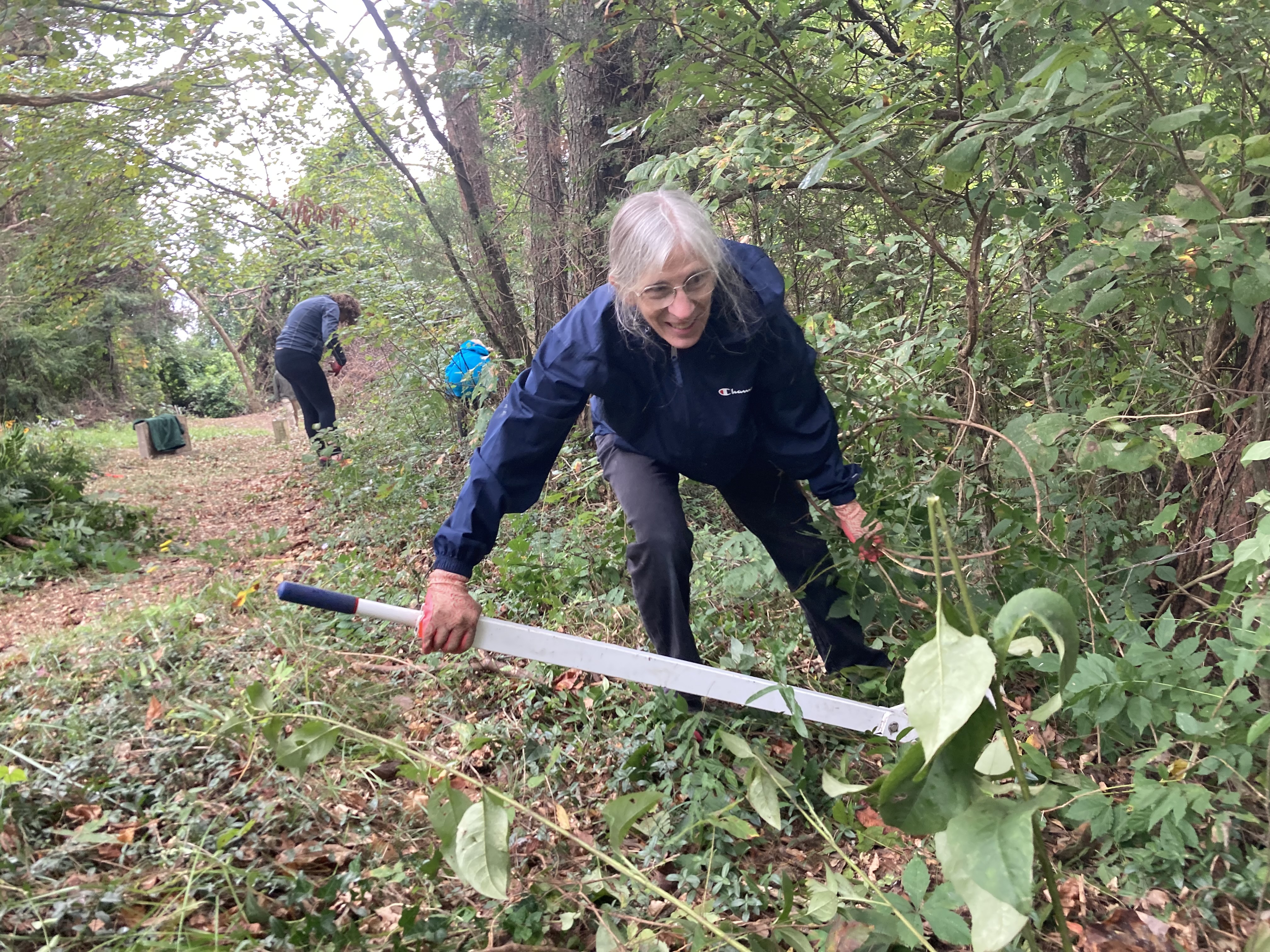Displaying items by tag: tennessee valley authority
A long, sad tale of when coal ash filled a valley so low
 In the early morning hours of Dec. 22, 2008, the earthen wall of a containment pond at Tennessee’s Kingston Fossil Plant gave way. The breach released 1.3 million cubic meters (1.7 cubic yards) of sludge, infiltrating a nearby river and damaging dozens of homes. NASA Earth Observatory
In the early morning hours of Dec. 22, 2008, the earthen wall of a containment pond at Tennessee’s Kingston Fossil Plant gave way. The breach released 1.3 million cubic meters (1.7 cubic yards) of sludge, infiltrating a nearby river and damaging dozens of homes. NASA Earth Observatory
Journalist’s book offers deep sweep of 2008 coal-ash disaster at TVA’s Kingston coal plant
CHATTANOOGA — Jared Sullivan’s book, Valley So Low, is “A courtroom drama about the victims of one of the largest environmental disasters in US history — and the country lawyer who challenged the notion that, in America, justice can be bought.” Those words from the publisher’s dust jacket sum up the story, but the pathos of workers, certain that they got sick on the job, and the lawyer’s struggle against a well-funded corporate defense, is in the details.
Most residents of the Tennessee Valley remember the 2008 disaster when a wall of a coal ash slurry rushed out of the Kingston Steam Plant, flooding the Emory River and inundating 300 acres of the surrounding countryside.
Sullivan offered insight into the story to an audience in Chattanooga in October. When workers fell ill after the cleanup, local personal injury lawyer Jim Scott challenged Jacob’s Engineering, a private company the Tennessee Valley Authority contracted to manage the cleanup. Scott was the only lawyer willing to take their case, according to Sullivan.
- jared sullivan
- kingston coal ash spill
- kingston coal ash spill book
- 2008 coal ash disaster
- coal ash cleanup
- coal ash spill
- coal ash contamination
- coal fly ash slurry
- valley so low
- valley so low review
- ray zimmerman
- chattanooga nature events
- tennessee valley authority
- is coal ash storage unsafe
- coal ash book
- environmental journalist
- environmental journalism
Learn about TVA’s switch from coal to natural gas at June 12 teach-in

‘Save Money, Save Energy’ Expo — at Ijams this Sunday
 Explore how to reduce your monthly power bill and increase the health and comfort of your home.
Explore how to reduce your monthly power bill and increase the health and comfort of your home.
Federal and local funding opportunities available at all income levels
KNOXVILLE — As the weather turns colder, many Knoxvillians start to worry about home heating bills. Fortunately, energy efficiency incentives and funding programs are available to Knoxvillians of all income levels through federal tax credits and rebates. Free local funding is available for qualifying customers of KUB through the “Home Uplift” program. Many Knoxvillians are unaware of these opportunities or unsure of how to access the funding programs.
Family-friendly Home Energy Expo
The local organizations that cooperate with small local businesses in the Save Money, Save Energy program and the expo and workshop at Ijams are the Southern Alliance for Clean Energy (SACE), Knoxville Utilities Board (KUB), Socially Equal Energy Efficient Development (SEEED), Sierra Club – Harvey Broome Group, Three3 (pronounced three cube) and Tennessee Interfaith Power and Light (TIPL).
Home Energy Expo at Ijams Nature Center, 2915 Island Home Ave, Knoxville, TN 37920 — Sunday, Nov. 5, 2023 from 1 p.m. to 4 p.m.
Save Money, Save Energy workshop starts at 2:30 p.m. (RSVP recommended to secure a seat)
- save money, save energy workshop
- home energy expo
- southern alliance for clean energy
- ijams nature center
- knoxville utilities board
- socially equal energy efficient development
- sace
- kub
- seeed
- harvey broome group of the sierra club
- three3
- tennessee interfaith power and light
- tipl
- home health
- home comfort
- energy efficiency
- home uplift
- tennessee valley authority
- tva
- electric vehicle expo
- solar power
- hvac
- solarpowered dollhouse
- utility bill
Keep the Tennessee River Beautiful receives State Recycling Award for Cigarette Litter Prevention Program with Dollywood
 The Tennessee Recycling Coalition presented its ‘2023 Nonprofit Recycler of the Year Award’ to Keep the Tennessee River Beautiful at their annual conference held in Gatlinburg, Tenn. in August. LEFT TO RIGHT: Amber Greene, Executive Director of the Tennessee Recycling Coalition; Edmond McDavis, Executive Director for the Tennessee Delta Alliance (who worked on the project when he was with Keep Tennessee Beautiful); Kathleen Gibi, Executive Director of Keep the Tennessee River Beautiful; Monica Kizer, Communications Director at Keep Tennessee Beautiful, and Lincoln Young, President of the Tennessee Recycling Coalition.
The Tennessee Recycling Coalition presented its ‘2023 Nonprofit Recycler of the Year Award’ to Keep the Tennessee River Beautiful at their annual conference held in Gatlinburg, Tenn. in August. LEFT TO RIGHT: Amber Greene, Executive Director of the Tennessee Recycling Coalition; Edmond McDavis, Executive Director for the Tennessee Delta Alliance (who worked on the project when he was with Keep Tennessee Beautiful); Kathleen Gibi, Executive Director of Keep the Tennessee River Beautiful; Monica Kizer, Communications Director at Keep Tennessee Beautiful, and Lincoln Young, President of the Tennessee Recycling Coalition.
Keep the Tennessee River Beautiful (KTNRB) was just named 2023 Nonprofit Recycler of the Year
Since the project launched at Dollywood in 2021, the program has led to the plastic getting recycled from approximately 350,000 cigarette butts. The project also made Dollywood the first theme park in the world to recycle the plastic from every cigarette butt collected in guest-facing receptacles on its property.
“We’re so proud of this honor, more than anything because of the commitment from Dollywood and the other supporting partners who worked to ensure that this trailblazing collaboration would protect the Tennessee River watershed from the harmful effects cigarette litter,” said Kathleen Gibi, KTNRB Executive Director.
“Taking the effort to the next step of recycling the plastic from otherwise discarded cigarette waste makes it all the more impactful and is yet the latest example of Dollywood’s reputation of working toward the greater good.”KTNRB was able to provide Dollywood with 26 art-wrapped cigarette receptacles through a collaboration of grants and sponsorships from Keep America Beautiful, Keep Tennessee Beautiful, the Tennessee Valley Authority (TVA), and the American Eagle Foundation.
Tennessee, home to TVA, is one of the least energy-efficient states in the country
 TVA’s Buffalo Mountain Wind Farm in East Tennessee generates 27 megawatts of electricity, which is enough to power over 2,000 homes. The 15 turbines have a capacity of 1.8 megawatts each. They are about 260 feet tall and their blades 135 feet long. The three original, smaller, turbines were decommissioned in 2009 and removed in 2021. TVA
TVA’s Buffalo Mountain Wind Farm in East Tennessee generates 27 megawatts of electricity, which is enough to power over 2,000 homes. The 15 turbines have a capacity of 1.8 megawatts each. They are about 260 feet tall and their blades 135 feet long. The three original, smaller, turbines were decommissioned in 2009 and removed in 2021. TVA
Tennessee ranks among the top one-third of states in total energy consumption.
Tennessee just earned a top spot on the “Least Energy-Efficient State” list.
A recent study by WalletHub determined which states lead the nation in energy efficiency. Tennessee ranked near the bottom of the list at No. 42.
The new report compared the conterminous 48 states to find out who was using the most and the least energy. The study excluded Alaska and Hawaii.
For some, this study is just another example of the Tennessee Valley Authority’s lack of response to the community and the environment.
Conjuring life at Worthington Cemetery
 Jimmy Groton, a Tennessee Citizens for Wilderness Planning board member, clears invasive plants at Worthington Cemetery in Oak Ridge during a volunteer work party in July. Ben Pounds/Hellbender Press
Jimmy Groton, a Tennessee Citizens for Wilderness Planning board member, clears invasive plants at Worthington Cemetery in Oak Ridge during a volunteer work party in July. Ben Pounds/Hellbender Press
Volunteers nurture life in an Oak Ridge cemetery
OAK RIDGE — The northern corner here is a small place teeming with treasures, including the Worthington Cemetery Ecological Study Area.
Elza Gate Park off Oak Ridge Turnpike, also known as Tennessee Highway 95, is the starting point for walking trails taking visitors through a cedar barren, a somewhat open habitat including eastern red cedars. The barrens include plants more similar to a prairie than many East Tennessee forests. The trail reaches a cemetery dating before the founding of Oak Ridge.
Woven together in this small area there is a natural mix of wildlife and historical preservation. Visitors to the loop trail will encounter a pine forest and a wetland area complete with a boardwalk to observe birds. Tennessee Valley Authority designated the land as both an Ecological Study Area and Small Wild Area.
- elza gate park
- oak ridge
- tennessee valley authority
- samuel worthington
- global ecology and conservation
- tennessee citizens for wilderness planning
- jimmy groton
- melton hill lake
- nature conservancy
- worthington cemetery ecological study area
- tva oak ridge
- twra
- red cedar barren
- tennessee prairie
- invasive plant control
- exotic species
- ann hewitt worthington
- citizen pest plant control
Tennessee Aquarium brings more baby sturgeon into the world
 A young lake sturgeon is viewed through a photographic aquarium after arriving at the Tennessee Aquarium Conservation Institute. Tennessee Aquarium
A young lake sturgeon is viewed through a photographic aquarium after arriving at the Tennessee Aquarium Conservation Institute. Tennessee Aquarium
Tennessee Aquarium welcomes 2,500 baby lake sturgeon as restoration effort turns 25 years old
Casey Phillips is a communications specialist at the Tennessee Aquarium in Chattanooga.
CHATTANOOGA — The approach of summer coincided with the arrival of thousands of juvenile lake sturgeon in the Tennessee Aquarium Conservation Institute.
Biologists at the Aquarium’s freshwater field station welcomed 2,500, 2-inch babies into their care. After a steady diet of bloodworms and brine shrimp, bringing the fish to at least 6 inches, they will be reintroduced into the Tennessee River.
These tiny fish hold tremendous promise. Adult lake sturgeon may reach lengths of 8 feet and live 150 years.
“They start out really small, so it’s shocking to think how big they can get,” says reintroduction biologist Sarah Kate Bailey. “The first year of life is when they grow the quickest.
“They grow so fast while we have them here. You’ll go home for the day, come in the next morning, and they look like they’ve grown overnight.”
- tennessee lake sturgeon
- sturgeon in tennessee river
- sturgeon recovery
- sturgeon reintroduction
- casey phillips writer
- lake sturgeon
- sarah kate bailey
- clean water act of 1972
- dr anna george
- chattannoga aquarium
- chattanooga environment
- Tennessee
- warm springs natural fish hatchery
- lake sturgeon working group
- tva
- tennessee valley authority
- reservoir water release
- tennesse wildlife resources agency
- tennessee aquarium conservation institute
- tennessee aquarium
Hellbent: Little River Watershed Association swims upstream to protect one of Earth’s great rivers
![Andrew Gunnoe, President of Little River Watershed Association]() Andrew Gunnoe is seen in the rain on Little River in Blount County, Tennessee. He is board director for Little River Watershed Association. Courtesy LRWA
Andrew Gunnoe is seen in the rain on Little River in Blount County, Tennessee. He is board director for Little River Watershed Association. Courtesy LRWA
Andrew Gunnoe helms spirited efforts to preserve beloved Little River but the current is swift
MARYVILLE — For 25 years, the handful of men and women involved with the nonprofit Little River Watershed Association (LRWA) have been protecting the crystal clear waters as they plummet from the Great Smoky Mountains before meandering through Blount County and merging with the Tennessee River.
“We see ourselves as the voice of the Little River, speaking for the river and its health,” said Andrew Gunnoe, president of the LRWA Board of Directors.
From the famous swimming hole at the Wye to the profusion of inner tube rental companies in Townsend, the Little River is one of the region’s most popular spots for water recreation. Further downstream, the waterway becomes an almost perfect spot for fishing, canoeing and kayaking.
For all the popularity as a recreation stop, the 59-mile stretch of water is also a vital habitat for numerous aquatic species and provides the 120,000-plus residents of Blount County with drinking water.
- little river diversity threat
- little river
- little river aqautic life
- little river watershed association
- preserving water quality
- maryville, tennessee
- townsend
- great smokies
- little river national park
- conservation fisheries
- biodiversity
- blount county
- tennessee valley authority
- escherichia coli
- tva
- e coli
- stream school
- university of tennessee environmental studies and sustainability
- sediment pollution
- water quality monitoring
To critics’ dismay, TVA plans to replace coal with natural gas. The utility also plans to double its solar supply.

Citizens call on TVA to stop passing gas
KNOXVILLE — The Tennessee Valley Authority in coming years plans to add both natural gas and solar plants to its portfolio to meet what it says are rising energy demands.
TVA’s Board of Directors laid out the federal utility’s plan in a meeting at Norris Middle School in May. Environmentalists at a previous hearing criticized the utility’s focus on natural gas rather than renewables or other measures. Other people, largely tied to local power providers, argued that a switch to renewable energy would be unreliable.
TVA showed a map in a press release following the meeting, showing four proposed natural gas plants and two proposed solar plants. Two of those natural gas plants would be in Tennessee while the other two are planned for Alabama and Kentucky. It stated these new plants will total 3,800 megawatts. It also spoke of its System Operations Center, set to open in fall 2024 in Georgetown to manage the utility’s grid. TVA also stated a desire to research nuclear technologies.
“Our region is experiencing growth at six times the national average, which means we must invest in our current power system and build new generation so we can continue meeting our region’s demand,” said TVA president and CEO Jeff Lyash.
Several citizens criticized TVA’s focus on natural gas plants and new pipelines at the listening session May 9. Among them was Clinton resident and activist John Todd Waterman.
- tva board
- tva board meeting
- tva climate change
- tva fossil plant
- climate action
- climate change appalachia
- jeff lyash
- system operations center
- natural gas
- natural gas power plant
- natural gas environment
- natural gas bad?
- tva kingston
- tva bull run
- john todd waterman
- tva systems operation center
- dana moran
- sierra club natural gas plant
- mark kimbell
- gallatin department of electricity
- coal plant replacement
- natural gas vs coal
- investment in new fossil fuel infrastructure
- fossil fuel
- fossil fuel industry
- fossil gas power plant
- tennessee valley authority
- climate change
- tva solar energy
- solar energy
- solar energy in tennessee
Updated: Her Oak Ridge story is finally told in a federal space

OAK RIDGE — For the month of April 2023, the exhibition can bee seen, Thursdays and Fridays from 10 a.m. to 2 p.m. and Saturdays from 10 a.m. to 3 p.m., at the Oak Ridge History Museum, which is housed in the Midtown Community Center at 102 Robertsville Road, Oak Ridge, TN. That building itself is a significant landmark of Oak Ridge history. Constructed 1944-45, it has been used as a bathhouse and laundry, a hangout for students, a senior center, the Oak Ridge Convention & Visitors Bureau, and office of the Oak Ridge Heritage and Preservation Association. Many long-term Oak Ridgers refer to it simply as the ”Wildcat Den,” harking back to the time it was home base of the high school’s football team, the Oak Ridge Wildcats that were national champions in 1958.
NORRIS — The W. G. Lenoir Museum in Norris Dam State Park will be hosting “HerStory: A Photography Exhibition of Women in the Secret City.” The exhibit will open on March 1, and be on display through the month in honor of Women’s History Month.
Constructed by the Civilian Conservation Corps (CCC) and opened in May 1936, Norris Dam State Park was managed by the Tennessee Valley Authority for 18 years prior to becoming a Tennessee State Park in 1953. Oak Ridge’s selection for the Manhattan Project was, in part, due to rural electrification that Norris Dam accomplished.
During the early 1940s, the park was closed to the public and the CCC vacation cottages winterized to house Manhattan Project workers. Later serving as a popular recreation destination for the growing government town, Norris Dam State Park continues to attract visitors from throughout the region. The construction of Norris Dam and Oak Ridge necessitated the relocation of countless families of the Clinch River valley by the federal government. These historical events connect these parks, and this new partnership will strive to tell the full stories of these places.
From janitors to homemakers and chemists, the women of the Manhattan Project worked hard and talked little. During WWII, Oak Ridge was a government town of 70,000 workers; primarily women who lived in a camp-like environment of barbed wire, security checkpoints, and code words. Workers were fingerprinted, interviewed, assigned a job, and given a clearance badge. Housing was limited and cramped and often unheated. Food at the cafeterias was in short supply and lines were long.
The photographs were taken by James Edward Westcott, a renowned photographer who worked for the U.S. government in Oak Ridge during the Manhattan Project and the Cold War. Westcott was one of the few people permitted to have a camera in the Oak Ridge area during the Manhattan Project. For more information call the Manhattan Project National Historical Park at (865) 482-1942.
— National Park Service
Wither wisteria: ‘People care about our land’
 Anne Child removes invasive exotic plants during a recent Tennessee Citizens for Wilderness Planning event to mark National Public Lands Day at TVA’s Worthington Cemetery in Oak Ridge. Ben Pounds/Hellbender Press
Anne Child removes invasive exotic plants during a recent Tennessee Citizens for Wilderness Planning event to mark National Public Lands Day at TVA’s Worthington Cemetery in Oak Ridge. Ben Pounds/Hellbender Press
Citizens pay it back on Public Lands Day in Oak Ridge, Smokies and beyond
OAK RIDGE — Rain drizzled as volunteers dug and clipped plants in woods around an old cemetery turned science lab.
It was a Public Lands Day event at Tennessee Valley Authority Worthington Cemetery Ecological Study area in Oak Ridge near Melton Hill Lake. Tennessee Citizens for Wilderness Planning, an environmental organization based in Oak Ridge, led the Sept. 24 work party in support of American public lands.
Other events were held throughout the country to mark the date (including Great Smoky Mountains National Park), which has proven itself to be the most productive day of the year for citizen sweat equity in public lands.
SACE released its annual utility decarbonization tracking report, and it’s not pretty
 Bloomberg reports that methane leaks from the natural gas sector may be far worse than estimated by the EPA. While replacing coal-fired power plants with natural gas ones reduces air pollution it may not help at all with climate change because methane is 30 times more effective as a greenhouse gas than CO2. Image source: Kayrros SAS
Bloomberg reports that methane leaks from the natural gas sector may be far worse than estimated by the EPA. While replacing coal-fired power plants with natural gas ones reduces air pollution it may not help at all with climate change because methane is 30 times more effective as a greenhouse gas than CO2. Image source: Kayrros SAS
Report: Many utilities are not reducing carbon emissions despite public assurances to the contrary
KNOXVILLE — Global greenhouse gas emissions must peak by 2025 and experience rapid and deep reductions to avoid a potentially catastrophic future, according to a new analysis by air-quality and climate advocates. Emissions must reach net zero by the early 2050s to limit warming to 1.5 degrees (C) in order to avoid the worst impacts of the climate crisis.
Many utilities and municipalities have acknowledged this dynamic, but the Southern Alliance for Clean Energy s fourth annual “Tracking Decarbonization in the Southeast" report highlights that current utility resource plans are not in line with this overarching target. Obstacles to getting utilities on track that are discussed in our report include: increasing reliance on fossil gas, underutilizing energy efficiency, and placing limitations on popular technologies such as rooftop solar. There’s still a lot of work to do before any Southeast utility is on track to decarbonize.
Court finds TVA contractor potentially liable for Kingston coal-ash cleanup injuries and deaths
 On Dec. 23, 2008, a massive dam at the Kingston coal-fired power plant in Harriman, Tenn., ruptured and spilled 1.1 billion gallons of coal ash into the Clinch and Emory rivers. Appalachian Voices teamed up with Southwings to take pictures from the air and launched two separate missions by water to test the river and fish for pollutants as a result of the spill. Appalachian Voices
On Dec. 23, 2008, a massive dam at the Kingston coal-fired power plant in Harriman, Tenn., ruptured and spilled 1.1 billion gallons of coal ash into the Clinch and Emory rivers. Appalachian Voices teamed up with Southwings to take pictures from the air and launched two separate missions by water to test the river and fish for pollutants as a result of the spill. Appalachian Voices
Contractor that cleaned up infamous TVA ash spill not immune from responsibility for alleged unsafe worksite
This story was originally published by Tennessee Lookout.
CINCINNATI — A federal appellate court last week struck down a last-ditch appeal by a Tennessee Valley Authority contractor accused in the mass poisoning by radioactive coal ash waste of the utility’s Kingston disaster workforce.
The 6th Circuit U.S. Court of Appeals ruled Jacobs Engineering Inc. cannot ride the coattails of TVA governmental immunity because TVA itself would not have been immune from liability had sickened workers chosen to sue the utility.
SACE works to keep us all warm this winter
This is a submission from the Southern Alliance for Clean Energy.
After public advocacy from Knoxville community members, the KUB board passed a resolution that will deliver $5 million for emergency bill assistance to benefit those most in need, and an additional $1 million for weatherization to improve the comfort of people’s homes while lowering their bills by increasing energy efficiency. These funds are part of a pandemic relief credit from TVA.
KUB staff proposed a resolution in October that would have allocated $1.3 million of the total $7.3 million TVA pandemic recovery credit toward payment of debt owed by KUB customers, and the remaining $6 million would be distributed as a monthly bill credit for all residential and small business KUB customers. This would have resulted in an average savings of $17 over 12 months, or about $1.40 per month for all KUB customers, regardless of their level of need for pandemic relief.
Knoxville Water and Energy for All (KWEA), a coalition which SACE is a part of, circulated a petition asking that KUB instead forgive all debt owed by KUB customers, and then use the remaining funds to assist households who were struggling to pay their KUB bills. KWEA delivered nearly 200 petition signatures, and the KUB board asked that the resolution be amended.
As a result of our coalition’s advocacy, the KUB board allocated not only the originally proposed $1.3 million for debt relief, but also the remaining $6 million for customers in need.
While KUB did not pledge to forgive all debt, this is certainly a major win for the community.
The KUB Board’s decision to reallocate funds demonstrates the power of our community speaking up to advocate for ourselves and our neighbors.
Lunker sturgeon are out there again: report your catch to receive a certificate
Email sturgeon.reports (at) tn.gov an image of your catch-and-release with the date, location and your name to obtain your official certificate! This email address is being protected from spambots. You need JavaScript enabled to view it.
WBIR: Holston River sturgeon surging
The population of lake sturgeon, a survivor since the Cretaceous Era that barely escaped the ravages of modern dams and reservoirs, is on the upswing in the Holston River and other branches and tributaries of the Tennessee River system. The last record of the fish in the valley before restoration efforts began is about 1960, according to WBIR.
Significantly older fish were identified during a recent inventory of sturgeon, giving hope that some fish were closing in on reproductive maturity. The gradual recovery is largely the result of Tennessee Wildlife Resources Agency and Tennessee Valley Authority restoration efforts, WBIR reports.
“It makes our valley richer; that fish is supposed to be here,” one researcher told WBIR about the significance of the so-far successful restoration of native sturgeon habitats.
Get involved: Protestors lock arms to demand TVA swear off fossil fuels for good
 Protestors chant and wave signs urging TVA to commit to a fossil fuel-free future during a protest in downtown Knoxville this summer. Courtesy Amy Rawe/Southern Alliance for Clean Energy
Protestors chant and wave signs urging TVA to commit to a fossil fuel-free future during a protest in downtown Knoxville this summer. Courtesy Amy Rawe/Southern Alliance for Clean Energy
Activists will demand TVA allow public comments during a protest planned for Wednesday morning outside TVA HQ in downtown Knoxville
Knoxville clean-air activists plan another protest Wednesday outside of Tennessee Valley Authority headquarters to demand a return to public-comment periods and a commitment the huge utility won’t rely on fossil-fuel energy sources in the future.
“Public input is critical right now, while TVA is considering building new, large fossil gas power plants and pipelines, even though they would be contrary to our need to cut greenhouse gas emissions in half by 2030,” said protest organizer Brady Watson of Southern Alliance for Clean Energy. Statewide Organizing for Community Empowerment is also coordinating the protest.
TVA project manager pleads guilty to falsifying reports

Hard Knox Wire: Failure to disclose financial conflicts could put TVA manager in prison
A former senior project manager at the Tennessee Valley Authority could spend up to five years in federal prison after he admitted to falsifying financial disclosure reports over several years.
TVA is the largest public electricity provider in the nation and is in the midst of a fraught effort to lessen its dependence on fossil fuels and reduce its carbon output.
James Christopher “Chris” Jenkins, 60, of Chattanooga, entered a guilty plea on Friday to one count of making a false official statement, according to a spokesperson from the U.S. Attorney’s Office, Hard Knox Wire reported.
He was accused of failing to disclose personal financial information during a conflict of interest probe, among other charges.
He faces a maximum prison sentence of five years plus up to three years of supervised release and $250,000 in fines when he’s sentenced in March by U.S. District Court Judge Travis R. McDonough.
FBI Special Agent in Charge Joe Carrico said the case was an example of the bureau’s commitment to fighting corruption.
“There is zero tolerance for those who exploit their official position for personal gain. It erodes public confidence and undermines the Rule of Law,” Carrico said. “We want the people we serve to know the FBI along with our law enforcement partners will hold those accountable who betray the public's trust.”
Clean-energy advocates take demands to base of TVA towers and power
 Alex Pulsipher holds a sign demanding that TVA transition to 100 percent renewable energy at a rally Wednesday in Market Square in Knoxville. Courtesy Amy Rawe/Southern Alliance for Clean Energy
Alex Pulsipher holds a sign demanding that TVA transition to 100 percent renewable energy at a rally Wednesday in Market Square in Knoxville. Courtesy Amy Rawe/Southern Alliance for Clean Energy
Varied environmental groups offer unified plea for clean energy, coal ash management and accountability from TVA
It was people power generating energy at Market Square in downtown Knoxville on Wednesday.
A coalition of civic and environmental groups and their representatives met at the bottom of the two Tennessee Valley Authority towers urging the public utility to reopen meetings to public comment; swear off all fossil fuels by 2030; and carefully tend to the needs of those affected by coal ash and devise a plan to contain it for the safety of current and future generations.
- tva clean energy
- coal ash
- kingston coal ash spill
- southern alliance for clean energy
- kingston coal ash worker
- tva coal ash
- sunrise movement
- appalachian voices
- sierra club
- tennessee valley authority
- accountability
- public comment
- tva board meeting
- carbon reduction
- climate action
- carbon free by 2030
- renewable energy
FGS calls on TVA to get serious about addressing the climate crisis
As Hellbender Press reported in April, the Tennessee Valley Authority plans to phase out its use of coal. And as we mentioned in an action alert, TVA is conducting a scoping process pertaining to the preparation of an Environmental Impact Statement (EIS) for retirement and replacement of the Kingston Fossil Plant. TVA is preparing similar EIS for its other remaining coal-fired power plants as well.
Although TVA lists "construction and operation of solar and storage facilities" in these scoping documents as an alternative for replacement of coal as the power source, it has made no secret of its belief that construction of gas-powered combustion turbines (CT) and natural gas pipelines to feed them will be the best solution to replace the outdated generation capacity.
Unlike other power utilities, TVA has been making it more difficult, financially unattractive or impossible for distributed renewable energy, storage and even efficiency projects to get realized, according to proponents of renewables and some of TVA’s local power distribution partners. TVA also reneged on its agreement with other utilities to make large amounts of wind power available to the Southeastern United States through the Plains & Eastern Clean Line high-voltage direct-current power line project.
- tennessee valley authority
- tva
- foundation for global sustainability
- fgs
- climate change
- climate crisis
- electric utility
- power plant replacement
- fossil fuel
- coalfired power plant
- gasfired power plant
- gas pipeline
- kingston fossil plant retirement
- distributed electricity generation and storage
- distributed energy resource
- solar energy
- power storage
- stranded asset
- germany
- renewable energy
- decarbonization
- plains & eastern clean line
Tell TVA: Don’t replace Kingston Coal with new fossil gas plants or pipelines!
 Remember TVA’s 2008 Kingston Fossil Plant coal fly ash slurry spill
Remember TVA’s 2008 Kingston Fossil Plant coal fly ash slurry spill
The Tennessee Valley Authority plans to retire the Kingston plant and its four other remaining coal-fired power plants by 2035.
But it is seriously considering replacing them with large fossil gas power plants and new gas pipelines!
Natural gas is cleaner than coal, but is yet another fossil fuel source that releases carbon dioxide. Such a replacement would be contrary to the national and global consensus that we must reduce the use of fossil fuels quickly to constrain the runaway climate crisis as much as we can.
A plan based on emerging technologies for increased energy efficiency combined with distributed use of renewable energies and energy storage can increase community resilience; create more good, long-term jobs; diversify local business opportunities; and provide immediate public health benefits.
TVA accepts public comments electronically through the end of July 15, 2021.
Don’t miss the opportunity to tell TVA that customers don’t want to pay for a yesteryear “solution” that does not really address the clear and present dangers to humanity. The Southern Alliance for Clean Energy has made it easy for you:
Submit your comment to TVA by tapping or clicking this link NOW:
Tell TVA, No New Fossil Gas Plants + Pipelines
You can also email TVA directly attn: Chevales Williams, This email address is being protected from spambots. You need JavaScript enabled to view it.
Source: TVA — Kingston Fossil Plant Retirement
- kingston fossil plant retirement
- tennessee valley authority
- tva
- coalfired power plant
- peaker power
- fossil fuel
- decarbonize
- electric power
- electric power plant
- kif
- fossil gas power plant
- natural gas
- power plant replacement
- coal ash spill
- coal fly ash slurry
- public comment
- renewable energy
- southern alliance for clean energy
- carbon dioxide
- co2
- energy storage
- distributed electricity generation and storage
- battery storage
- climate crisis
